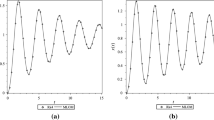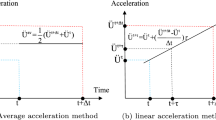Abstract
Complex dynamic systems are described by differential dynamic equations, mostly nonlinear without closed form analytic solution. To solve them numerically, there are many methods such as Euler’s method, Taylor-series method and Runge-Kutta method, etc., each with advantages and disadvantages. In this chapter, a novel analytical and numerical methodology for the solutions of linear and nonlinear dynamical systems is introduced. The piecewise constant argument method combined with the Laplace transform, makes the new method called Piecewise constant argument-Laplace transform (PL). This method provides better reliability and efficiency for solving coupled dynamic systems. In addition, the numerical solutions of linear and nonlinear dynamic systems can be obtained smoothly and continuously on the entire time range from zero to t. The numerical results of the analytical solution of the method are given and compared with the results of the 4th-order Runge-Kutta (RK4) method, and the accuracy and reliability of the PL method are verified.
Access this chapter
Tax calculation will be finalised at checkout
Purchases are for personal use only
Similar content being viewed by others
References
Abukhaled MI, Allen EJ. A class of second-order Runge-Kutta methods for numerical solution of stochastic differential equations. Stochastic Analysis & Applications. 1998, 16(6):977–991.
Cai ZF, Kou KI. Laplace transform: a new approach in solving linear quaternion differential equations. Mathematical Methods in the Applied Sciences. 2018, 41(11):4033–48.
Chen Z, Qiu Z, Li J. Two-derivative Runge-Kutta-Nyström methods for second-order ordinary differential equations. 2015, 70(4):897–927.
Butcher, JC. Numerical Methods for Ordinary Differential Equations. Ussr Computational Mathematics & Mathematical Physics. 2010, 53:153–170.
Dai LM. Nonlinear Dynamics of Piecewise Constant Systems and Implementation of Piecewise Constant Arguments: World Scientific; 2008.
Iserles A, Ramaswami G and Mathematics M. Runge-Kutta methods for quadratic ordinary differential equations. Bit Numerical Mathematics. 1998, 38(2):315–46.
Hussain, Kasim A, Ismail F. Fourth-Order Improved Runge-Kutta Method for Directly Solving Special Third-Order Ordinary Differential Equations. Iranian journal of ence and technology. transaction a, 2017,41:429–437.
Ji XY, Zhou J. Solving High-Order Uncertain Differential Equations via Runge-Kutta Method. IEEE Transactions on Fuzzy Systems 2017:1–11.
Kanagarajan K, Suresh R, Mathematics A. Runge-Kutta method for solving fuzzy differential equations under generalized differentiability. 2016, 14(14):1–12.
Forcrand PD, Jäger B. Taylor expansion and the Cauchy Residue Theorem for finite-density QCD. The 36th Annual International Symposium on Lattice Field Theory. 2018.
Zingg DW, Chisholm TT. Runge-Kutta methods for linear ordinary differential equations. Applied Numerical Mathematics 1999, 31:227–238.
Zhang CY, Chen L. A symplectic partitioned Runge-Kutta method using the eighth-order NAD operator for solving the 2D elastic wave equation. Journal of Seismic Exploration. 2015, 24:205–230.
State Locus Drawing of RLC Circuit Based on Ode45 of MATLAB. China Science and Technology Information, 2008.
Immler, Fabian, Traut C. The Flow of ODEs: Formalization of Variational Equation and Poincaré Map. Journal of Automated Reasoning, 2019, 62(2):215–236.
Hartman, Philip. Ordinary differential equations. Mathematics of Computation.1982, 20:82–122.
Dai LM, **a DD, Chen CP, An algorithm for diagnosing nonlinear characteristics of dynamic systems with the integrated periodicity ratio and lyapunov exponent methods, Communications in Nonlinear Science and Numerical Simulation, 2019, 73: 92–109.
Dai LM, Wang X, Chen C. Accuracy and Reliability of Piecewise-Constant Method in Studying the Responses of Nonlinear Dynamic Systems. Journal of Computational and Nonlinear Dynamics. 2015, 10(2):021009–10.
Dai LM, Singh MC, Structures. An analytical and numerical method for solving linear and nonlinear vibration problems. International Journal of Solids & Structures. 1997, 34(21):2709–2731.
Lu X, Sun J, Li G, Wang Q, Zhang D. Dynamic analysis of vibration stability in tandem cold rolling mill. Journal of Materials Processing Technology. 2019, 272:47–57.
Reyhanoglu M, van der Schaft A, Mcclamroch NH, Kolmanovsky I. Dynamics and control of a class of underactuated mechanical systems. IEEE Transactions on Automatic Control, 2017, 44(9):1663–1671.
Bryant P, Brown R, Abarbanel H. Lyapunov Exponents from Observed Time Series. Phys. rev. lett. 1990, 65(13):1523–1526.
Zhang W, Ye M. Local and global bifurcations of valve mechanism. Nonlinear Dynamics. 1994, 6(3):301–316.
Wolf A, Swift JB, Swinney HL, Vastano JA. Determining Lyapounov exponents from a time series. Springer Berlin Heidelberg. 1985, 16(3):285–317.
Jung C. Poincare map for scattering states. Journal of Physics A General Physics 19.8(1999):1345.
Dai, LM, Singh MC. Periodic, quasiperiodic and chaotic behavior of a driven Froude pendulum. International Journal of Nonlinear Mechanics. 1998, 33(6):947–965.
Ma H, Ho DWC, Lai YC, Lin W. Detection meeting control: Unstable steady states in high-dimensional nonlinear dynamical systems. Physical Review E. 2015.92.
Zhang W, Wang FX, Zu JW. Local bifurcations and codimension-3 degenerate bifurcations of a quintic nonlinear beam under parametric excitation. Chaos, Solitons & Fractals. 2005, 24(4):977–98.
Fang P, Dai LM, Hou YJ, Du MJ, Wang LY, ** ZJ. Numerical Computation for the Inertial Coupling Vibration System Using PL Method. Journal of Vibration Engineering & Technologies, 2019, 7(2):139–148.
Dai L, Assessment of Solutions to Vibration Problems Involving Piecewise Constant Exertions, Symposium on Dynamics, Acoustic and Simulations (DAS2000) in ASME IMECE 2000, Orlando, 2000.
Arendt W, Batty CJ, Hieber M, Neubrander F. Vector-Valued Laplace Transforms and Cauchy Problems. Israel Journal of Mathematics. 1987, 59(3):327–352.
Fang P, Dai L, Hou Y, Du M, Wang L. The Study of Identification Method for Dynamic Behavior of High-Dimensional Nonlinear System. Shock and vibration. 2019.
Fang P, Hou YJ, Zhang LP, Du MJ, Zhang MY. Synchronous behavior of a rotor-pendulum system. Acta Physica Sinica. 2016, 65.
Author information
Authors and Affiliations
Editor information
Editors and Affiliations
Rights and permissions
Copyright information
© 2022 The Author(s), under exclusive license to Springer Nature Switzerland AG
About this chapter
Cite this chapter
Pan, F., Liming, D., Kexin, W., Luyao, W. (2022). Improved Theoretical and Numerical Approaches for Solving Linear and Nonlinear Dynamic Systems. In: Dai, L., Jazar, R.N. (eds) Nonlinear Approaches in Engineering Application. Springer, Cham. https://doi.org/10.1007/978-3-030-82719-9_1
Download citation
DOI: https://doi.org/10.1007/978-3-030-82719-9_1
Published:
Publisher Name: Springer, Cham
Print ISBN: 978-3-030-82718-2
Online ISBN: 978-3-030-82719-9
eBook Packages: EngineeringEngineering (R0)




